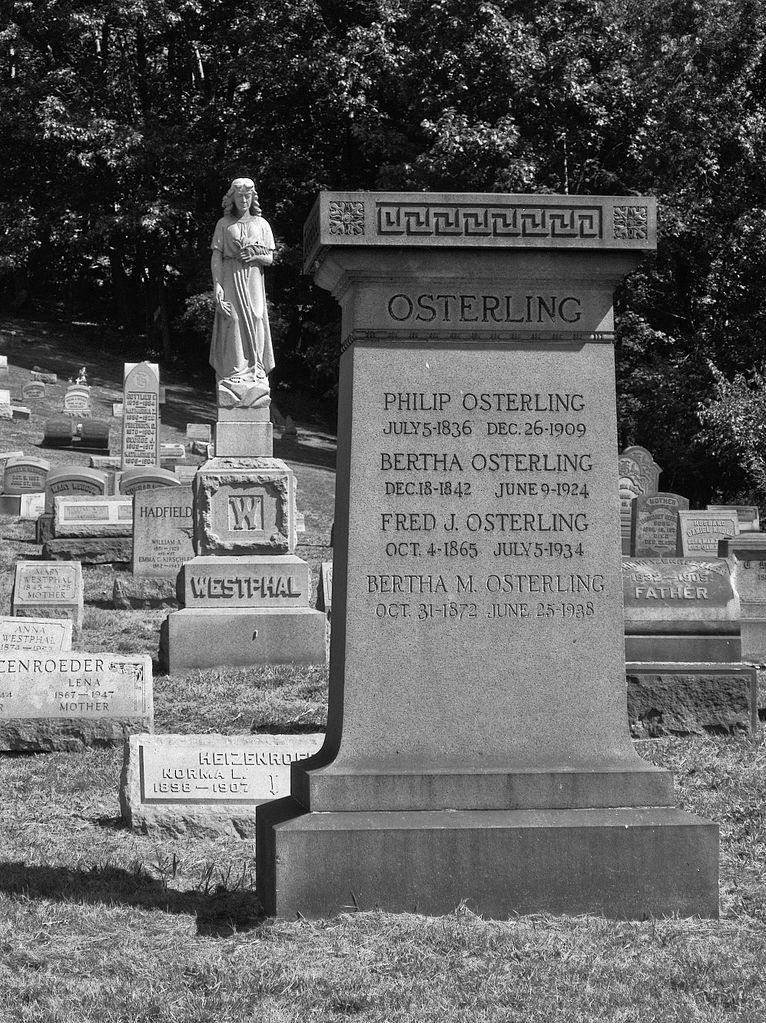
The Arrott Building is the most lavishly ornamented of the Fourth Avenue bank towers. The ornaments near the top may be best appreciated from another one of the Fourth Avenue bank towers—or with a very long lens from the street.

This 1890 building was designed by Frederick Osterling, who also gave us the Arrott Building and the Union Trust Building. It now functions as a kind of parasite on the skyscraper Bell Telephone Building next door, but it is still an impressive work of architecture.

The only way to get a complete view of the Grant Street front of the Union Trust Building is with a composite of several photos. There are stitching errors, including a spooky phantom wheel rolling down Grant Street, but at least the picture gives us a better idea than we usually get of the face of this massive building, which was intended by Henry Frick to be the best shopping arcade in the country. It was designed in the Flemish Gothic style by Frederick Osterling.

Sometimes one finds things one didn’t know one was looking for. Father Pitt had decided to visit Rosedale Cemetery in Ross Township, a small German cemetery that does not show up on many maps, and here it was: the Osterling family monument, with “Fred J. Osterling” inscribed on it. By the dates we know that this is Frederick Osterling, the great architect, and the monument itself is so strikingly tasteful that one suspects Mr. Osterling designed it himself for his parents.
Frederick Osterling is responsible for some of the most important buildings in Pittsburgh:
The Union Trust Building
The Armstrong Cork Factory
The Westinghouse “Castle”
The Arrott Building
The morgue
The Times Building
—among many others. His career pretty much ended with the Union Trust Building, however; the client, Henry Frick, refused to pay Osterling’s fee when the construction ran late, and Osterling sued. After a decade in various courts, the case of Osterling v. Frick ended in victory for Osterling; but meanwhile it seems that Frick, who was good at holding grudges, had made sure Osterling would never work again. On the other hand, it seems he didn’t really need to work: when he died in 1934, Osterling left an estate valued at a million dollars, which was a good bit of money in those days.
The Bertha Osterling whose name appears below Fred’s name is one of Frederick’s sisters, who apparently never married. Frederick never married, either; but, when he died with a million dollars in his estate, he left $10,000 of it to a certain Martha O. Aber in a handwritten codicil to his will (the rest went to his sisters Bertha and Anna). This woman then claimed to be his secret wife, and demanded a much larger share of the estate. Old Pa Pitt does not know what happened after that.

Frederick Osterling, one of Pittsburgh’s most interesting architects, designed the Armstrong Cork Company buildings, a masterpiece of functional yet attractive industrial architecture. They have now been turned into expensive loft apartments. You can see the buildings from a different angle here.

Frederick Osterling built this charming little building in 1917 to be his office and studio. From it he had a fine view of the Pittsburgh skyline that he was helping shape—a view now blocked by the new Alcoa building.

Now converted to loft apartments and known as “The Cork Factory,” this landmark of industrial architecture was designed by Frederick Osterling. Here we see it from Washington’s Landing on a grey day. Since the weather was mopey, Father Pitt decided to make this picture look as much as possible as though it could have been made in 1901, when the buildings were new; but in fact it was taken just this afternoon.

This splendid palace, officially the Westinghouse Air Brake Company General Office Building, presides benevolently over the pleasant company town of Wilmerding. The architect of the main part was Frederick Osterling, one of the great names in Pittsburgh architecture; the section at the left end was added later.
As a kind commenter notes, this is a bit of a white elephant for the little borough: it needs restoration work, but its out-of-the-way location makes it hard to sell. For a while it was operated as a museum of things Westinghouse, but the small nonprofit group that owned it could not afford the major renovations necessary to keep it open. One plan that has been fermenting for some time is to turn it into a boutique hotel.




This is the building as it looked in about 1905, before the addition.

Frederick Osterling designed this atmospherically Romanesque morgue to match Richardson’s courthouse and jail a block away. Generations of Pittsburgh teenagers made a tradition of visiting the morgue after the prom. This curious memento mori is one of those Pittsburgh customs that old Pa Pitt must simply file away as unaccountable, not even attempting an explanation; unless it be that the visit to the morgue, by a direct appeal to all the senses at once, was intended to achieve what Mr. Andrew Marvell attempted to achieve by verse alone.
The morgue is a short walk from the First Avenue subway station.